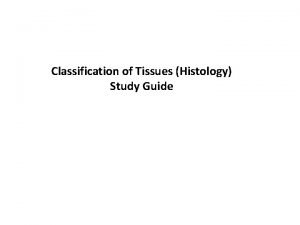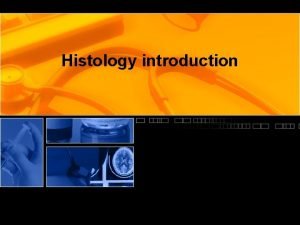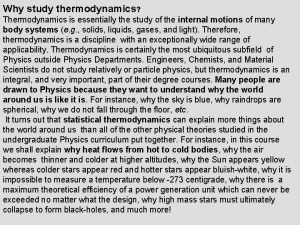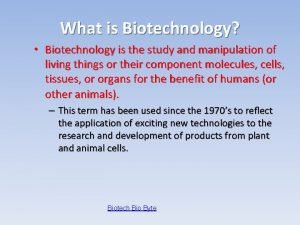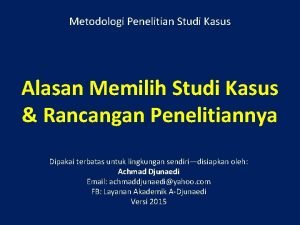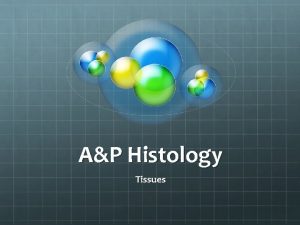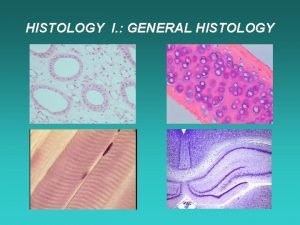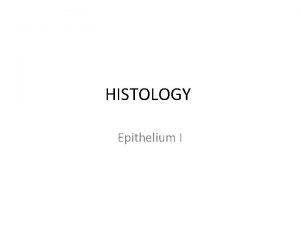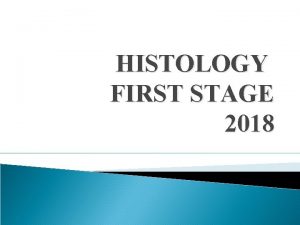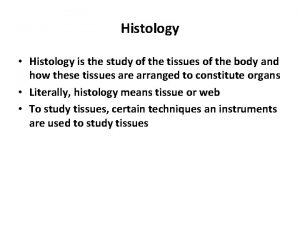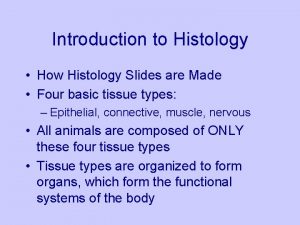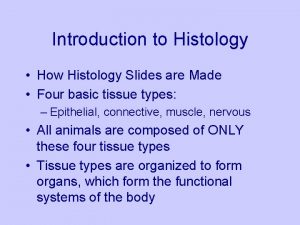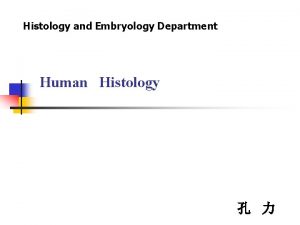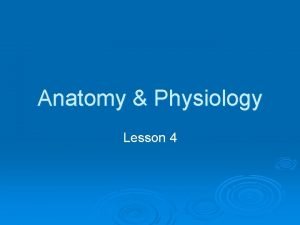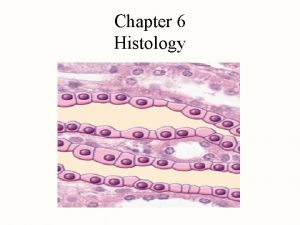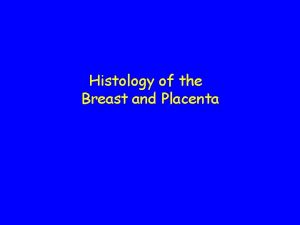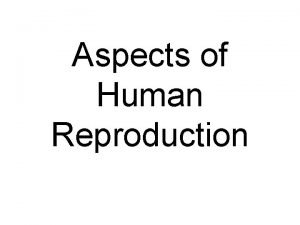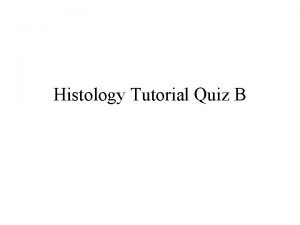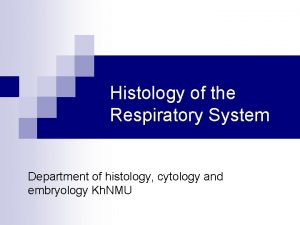INTRODUCTION I Whats histology II Why we study





























- Slides: 29

INTRODUCTION

I. What’s histology? II. Why we study it ? III. How to study it ? -Histological study methods.

I. What’s histology? Histology (Greek words): histo-tissue logia-study of , or knowledge of So, histology means the knowledge of tissue, is a branch of Anatomy. Structures related to function. So, exactly, Histology is a science which study the microstructure and the relationship between the structure and function of human being.

Cell: smallest unit of structure and function of body tissue: group of cell & extracellular ground substance four basic tissue: ---epithelium ---connective tissue ---muscular tissue ---nervous tissue organ: made up of tissue, have special shape, structure and function system: organs Which have related function get together.

n It is the bases of other subject in medicine ? . YES It intertwines the disciplines of cell biology, biochemistry, physiology, and pathology. Students will recognize the importance of this subject as they refer to the text later in your careers.

Microscope Dr. Nabil khouri

MICROSCOPE v. A microscope is an instrument used to see objects that are too small for the naked eye. v. The science of investigating small objects using such an instrument is called microscopy. v. Microscopic means invisible to the eye unless aided by a microscope.

Parts and Functions of a Compound Microscope

Light Microscope SIMPLE COMPOUND Uses single lens Uses set lenses or a lens system

Compound Microscope Mechanical Parts Magnifying Parts Illuminating Parts Adjustme nts and Support Enlarge the specimen Provide the light

Mechanical Parts o Base – Bottommost portion that supports the entire/lower microscope o Pillar – Part above the base that supports the other Inclination Joint parts Pillar o Inclination Joint Base – Allows for tilting of the microscope for convenience of the user

Mechanical Parts o Arm/Neck – Curved/slanted part which is held while carrying the Arm / Neck microscope o Stage – Platform where object to be examined is placed o Stage Clips – Secures the specimen to the stage Draw Tube Body Tube Stage

Mechanical Parts o Stage Opening o Body Tube – Attached to the arm and bears the lenses o Draw Tube – Cylindrical structure on top of the body tube that holds the ocular lenses

Mechanical Parts o Revolving/Rotating Nosepiece – Rotating disc where the objectives are attached o Dust Shield – Lies atop the nosepiece and keeps dust from settling on the objectives Dust Shield Revolving Nosepiece

Coarse Adjustment Knob Fine Adjustme nt Knob o Coarse Adjustment Knob – Geared to the body tube which elevates or lowers when rotated bringing the object into approximate focus o Fine Adjustment Knob – A smaller knob for delicate focusing bringing the object into perfect focus

Mechanical Parts • Condenser Adjustment Knob – Elevates and lowers the condenser to regulate the intensity of light • Iris Diaphragm Lever Iris – Lever in front of the Diaphragm Lever condenser and which is moved horizontally Condenser Adjustment Knob to open/close the diaphragm

Illuminating Parts o Mirror – Located beneath the stage and has concave and plane surfaces to gather and direct light in order to illuminate the object o Electric Lamp – A built-in illuminator beneath the stage that Mirror / may eb used if sunlight Electric Lamp is not preferred or is not available

MAGNIFYING PARTS • Ocular / Eyepiece – Another set of lens found on top of the body tube which functions to further magnify the image produced by the objective lenses. It usually ranges from 5 x to 15 x. Ocular/ Eyepiece Objectives

MAGNIFYING PARTS • Objectives – Metal cylinders attached below the nosepiece and contains especially ground and polished lenses • LPO / Low Power Objective – Gives the lowest magnification, usually 10 x • HPO / High Power Objective – Gives higher magnification usually 40 x or 43 x • OIO / Oil Immersion Objective – Gives the highest magnification, usually 97 x or 100 x, and is used wet either with cedar wood oil or synthetic oil

Total Magnification = Objective lens X Eyepiece lens e. g. What is the total magnification if the objective lens is twenty times (X 20) and the eyepiece lens five times (X 5)? Magnification = 20 X 5 = X 100

As magnification increases, detail increases but Onion cell 40 x Onion cell 100 x Onion cell 400 x less of the cell is seen

Caring for the Microscope 1. Do not let any liquids to come in contact with the microscope. 2. Always store the microscope inside a box after use. 3. Return the objective lens onto low power after use. 4. Carry the microscope by the arm. 5. Use a soft clean tissue to wipe the lenses

Electron Microscopy • • Electron beam as source (l ~ 0. 005 nm) Operate under vacuum Electromagnets instead of glass lenses Detect by fluorescent screen or photographic emulsion • Destructive • Two major types – Transmission (TEM) and scanning (SEM)

TEM Cellular ultrastructure Bright portion – e- pass through Dark portion – e- absorbed or scattered Sections – 50 – 150 nm Fix – glutaraldehyde Stains (e- dense; heavy metals) Osmium tetroxide (Os. O 4) – lipids Uranyl acetate, Lead citrate – nonspecific (surface adsorbed) Ruthenium red – complex carbohydrates

SEM • Surface ultrastructure • Fixed, dried, coated with gold before imaged • e- reflected from surface – Results in 3 -D like image

1. structure of Microscope LM EM ---useful magnification: 1500 X 800, 000 X ---resolution: 0. 2 um 0. 2 nm

SEM image TEM image

Problems & Pitfalls • Shrinkage – fixation and embedding – Appearance of empty spaces • Empty spaces due to loss of material – Improper fixation and dehydration • Wrinkling • Precipitation of stains (may appear as dark spots all over the section) • Do not memorize images - learn morphological criteria • Do not rely on color

 Why why why why
Why why why why Whats histology
Whats histology Simple squamos
Simple squamos Don't ask why why why
Don't ask why why why Introduction to histology
Introduction to histology Whats hot whats not
Whats hot whats not Whats feasibility study
Whats feasibility study Phases of matter foldable
Phases of matter foldable Ecological study vs cohort study
Ecological study vs cohort study Retrospective cohort study vs prospective cohort study
Retrospective cohort study vs prospective cohort study Critical examination in method study
Critical examination in method study Marty lobdell study less study smart
Marty lobdell study less study smart Phytogeographical region of india
Phytogeographical region of india Distinguish between motion study and time study
Distinguish between motion study and time study Differentiate between time study and motion study
Differentiate between time study and motion study Gerrc paragraph
Gerrc paragraph Pressure is state function or path function
Pressure is state function or path function Why study financial markets
Why study financial markets Biotechnology
Biotechnology Kenapa memilih studi kasus
Kenapa memilih studi kasus Development economics
Development economics Why study earth science
Why study earth science What are study skills and why are they important
What are study skills and why are they important What is syntax
What is syntax What are study skills and why are they important
What are study skills and why are they important Why study entrepreneurship
Why study entrepreneurship Nature of business finance
Nature of business finance Language
Language Why do geographers study religion
Why do geographers study religion Short essay on nature
Short essay on nature


